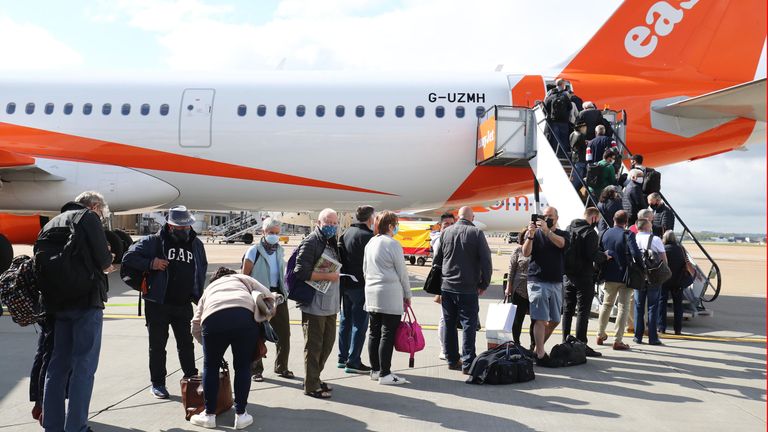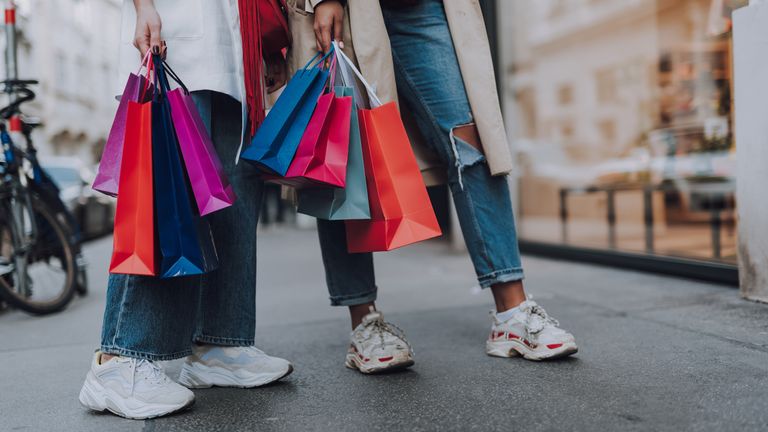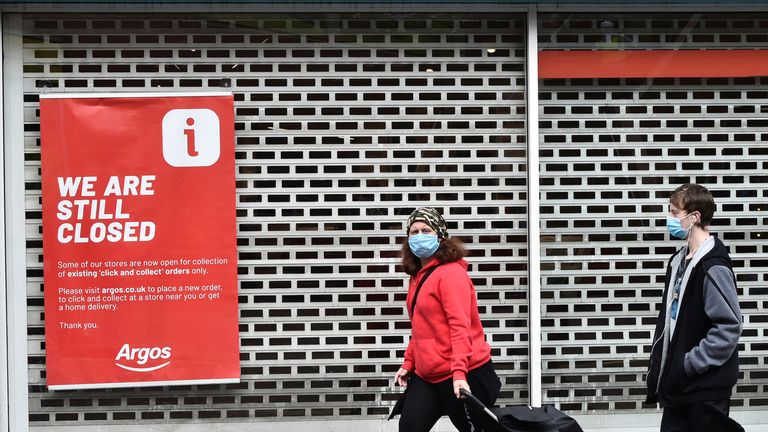From keen diners to cautious shoppers: How consumers are responding as rules ease
Latest data paints a mixed picture on how quickly different parts of the economy - and different regions - are starting to recover, while pointing to challenges that employers and workers may still face.
Friday 30 July 2021 04:49, UK
Health statistics have dictated our lives in so many ways for 16 months.
From lockdowns to travel restrictions, the numbers of COVID cases, hospitalisations, deaths and, more recently, vaccinations have been the framework within which both political and personal decisions have been forged.
We're now at what feels like something of a junction.
Almost all restrictions have been lifted, but confirmed cases remain extremely high, over 31,100 on Thursday, up for the second day in a row after they appeared to be receding slightly last week.
But crucially, hospitalisations and deaths still remain significantly lower than they were during the terrible first and second waves, with vaccines estimated to have prevented some 60,000 British deaths.
In that context, how is the population feeling and behaving? How are businesses and the economy faring?
What changes brought by this pandemic are bedding in as permanent, and what might still lie ahead of us?
New consumer behaviour data indicates that confidence may be gradually returning.
Take the number of daily flights, for example.
Last week, ending 25 July, the rolling average of flights rose 17% on the week before and reached its highest level since the start of the first lockdown.
This is certainly encouraging.
It reflects the recent relaxations in travel restrictions, particularly the fact the double-jabbed no longer have to isolate on return from amber list countries.
But despite the fact some people clearly do want to travel, the volume of flights is still barely half of what it was at the same point last year.
So what about an area of life where there are no longer any restrictions at all?
Retail footfall is indicative.
It has fluctuated wildly over the course of the pandemic and although it has recovered and stabilised to a degree, last week the number of people out and about was still 77% lower than the same week in 2019.
Some of that could be down to continued caution, but a lot could also be because habits have permanently shifted, with increased online shopping here to stay.
That seems even more likely when compared to how regularly we are heading out to eat at restaurants.
Data from OpenTable shows that the number of people who sat down to eat at pubs, bars and restaurants last week was up 119% on the same week in 2019.
There were, however, significant regional differences, with the recovery in London notably weaker than in Manchester.
So it would seem there is a mixed picture for business, depending on your line of work.
We've heard a lot about the so-called "pingdemic", but there are other more structural challenges for business too.
A big one is a lack of staff.
Data on job vacancies shows that, despite the number of openings plummeting dramatically when the pandemic struck, they have now recovered to not only surpass their pre-pandemic levels, but are in fact higher than they've been at any time over the last 20 years.
It's surprising given the economy is still recovering from an historic shock and even more so when you consider that vacancies took over five years to recover following the financial crash of 2008/2009.
Things are particularly bad in sectors such as construction, logistics and transport.
The number of online job adverts for roles in transport, logistics and warehouses is up over 300% compared with February 2020.
Why?
Some people have stopped working because of things like extra caring responsibilities and fear of the virus, while a number of EU workers have opted to go home following Brexit.
But more significantly, there is also the continuation of the furlough scheme.
The latest numbers show that within surveyed businesses, 4.9% of the workforce is still on full or partial furlough.
The Office for National Statistics estimates that somewhere between 1 million and 1.5 million workers are still away from their jobs.
That is a large number given that the economy has officially reopened and the scheme is starting to taper off.
For context, HMRC says that 11.6 million jobs in total have been furloughed at some point over the scheme's life cycle.
It's not clear yet how many of those people will find new jobs when it ends.
Also unclear is whether they will fill the vacancies that exist.
The Bank of England has forecasted that unemployment could rise by around 250,000 in the third quarter of the year - that's only around a fifth of the people on furlough.
Among all the data and numbers we have to assess this pandemic, one of the hardest things to pin down is how people feel about continuing restrictions and how they are opting to interpret data in their own lives.
One clue is the degree to which people are adhering to self isolation rules.
Although the majority in all age groups say they have self isolated when required, there has been a significant drop in the degree of adherence among the under-35s.
In the first week of July only 75% said they isolated when needed.
It's perhaps one of the best indications of underlying frustration at how this pandemic continues to shape lives and decide fortunes.











